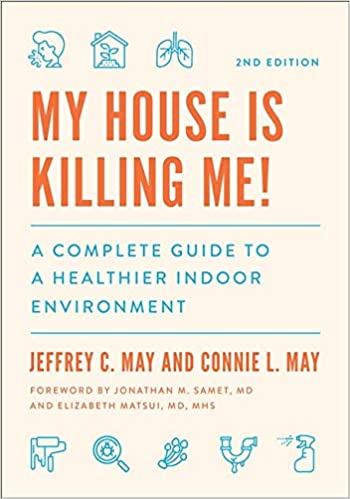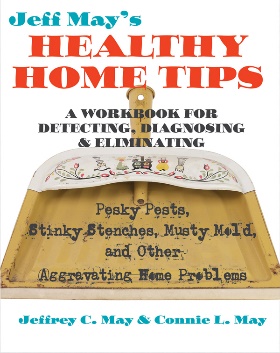IAQ IQ Winter, 2020-2021
©2021 Jeffrey C. May
I have investigated over 2,500 “sick” buildings in which occupants were experiencing symptoms such as shortness of breath, sinus congestion, chronic cough, headaches, and even fatigue. I once compared 600 “sick” homes (SHs) to 300 “control” houses (CHs) that I had inspected as part of real estate transactions (as many of you know, I used to be a home inspector). The results told me a lot about building conditions that can lead to indoor-air-quality (IAQ) problems.
- 41% of the SHs had forced hot-air heat, compared to 29% of the CHs.
- 37% of the SHs had central air conditioning, compared to 19% of the CHs.
- In 81% of the SHs, I found elevated levels of spores from indoor mold growth, especially Pen/Asp spores from Penicillium and/or Aspergillus mold.
- In a subset of 47 SHs in which I sampled exposed fiberglass insulation in basements or crawlspaces, 74% of the insulation batts contained significant mold growth. And 31% of the insulation batts contained mold-eating mites, which produce allergenic fecal matter.
- In another subset of 37 SHs in which I sampled the dust on baseboard heating convectors close to concrete floors, 37% contained significant mold growth in the fin-tubing dust.
Problem areas in homes and other buildings most likely to be sources of bioaerosol (airborne particles of biological matter) from microbial growth (mold, bacteria, yeast) include humidifiers, HVAC equipment, unfinished basement floors and wall surfaces, carpeting below-grade, pet beds and kitty litter boxes, and believe it or not, refrigerators.
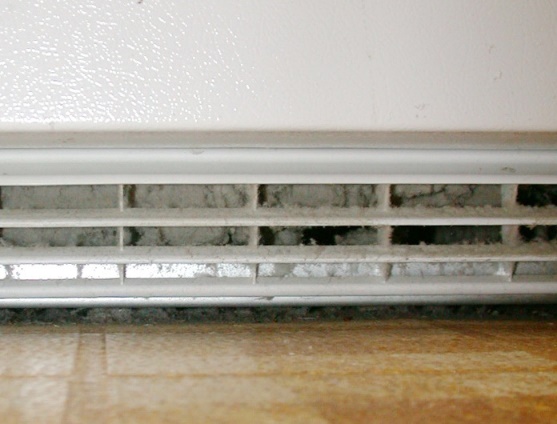
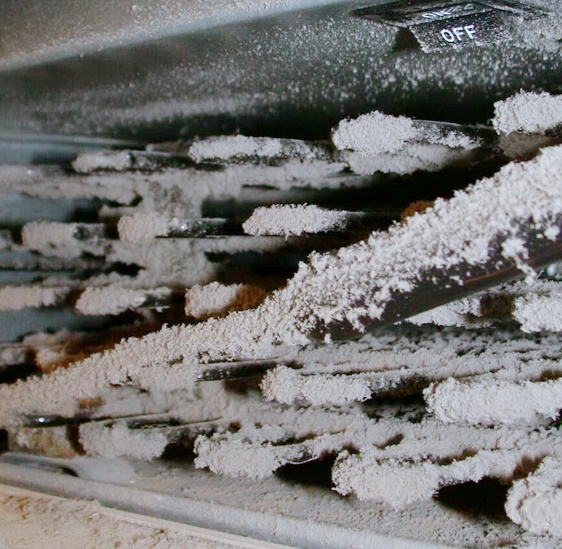
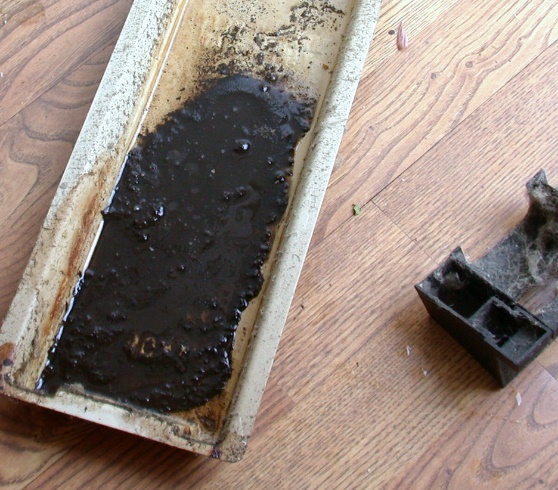
Below are some case-study summaries of some inspections I did of SHs:
- My client moved into a one-year old home. She did not dehumidify the basement, which to her knowledge have never experienced water intrusion. She used to exercise in her basement but experienced such severe shortness of breath that she had to stop. Her physician diagnosed her as having the respiratory illness hypersensitivity pneumonitis (HP). I found high concentrations of Pen/Asp spores in the basement air. She stopped exercising in her basement and her health improved.
- The occupant was concerned about a musty odor that seemed strongest on the first floor. The house used to have a duct system that had been replaced by a hot-water system. The old ducts, however, remained in place, though the furnace had been removed. I found a highly elevated concentration of Pen/Asp spores in the basement, and basement air containing the spores was flowing up through the abandoned ducts to the first floor.
- A couple moved into a new home; shortly thereafter, their 18-month old baby experienced asthma and needed regular nebulizer treatments. Allergy testing confirmed that the baby had pet allergies. The previous owners had a dog and a cat. I found many dog-dander particles in the air, and mold spores as well as dog- and cat-dander particles in the dust on the baseboard heating convectors.
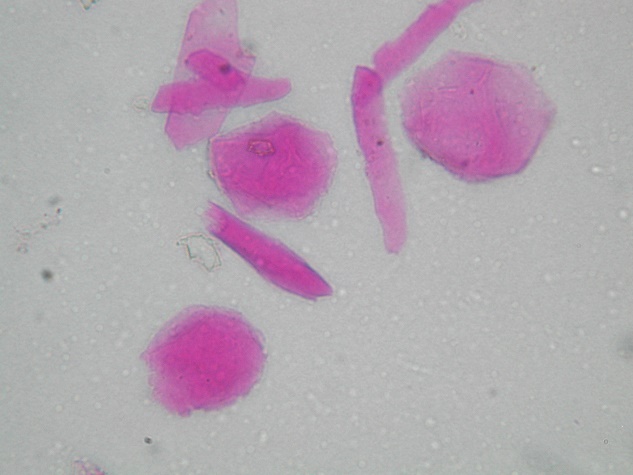
In Massachusetts at least, home inspectors aren’t required to comment on environmental conditions, but it’s useful to know what conditions might lead building professionals to recommend that their clients hire an IAQ inspector (especially if a client has allergies or asthma), just as you might recommend a pest inspector (if you don’t include pest inspections in your services), or a structural engineer.
These conditions include:
- Musty smelling basement or garage
- An old, paneled finished basement
- A dirt crawlspace
- A crawlspace vented to the exterior
- Ducts in a crawlspace.
On your inspections I encourage you to open up a furnace, heat pump, or A/C fan coil. If you see exposed fibrous lining material that looks dusty, or if the filter slot has not been airtight, then an HVAC technician should inspect the unit and clean it as needed. The unit may have to be dismantled to do a decent cleaning job, and exposed fibrous lining material should be replaced with closed-cell foam.
I am attaching a sheet of tips you can share with your clients who are concerned about IAQ. You can also refer them to our books, which offer a lot of practical advice for improving the quality of indoor air. Available on line, the books are published by Johns Hopkins University Press.
I wish you all a healthy 2021.
Jeff
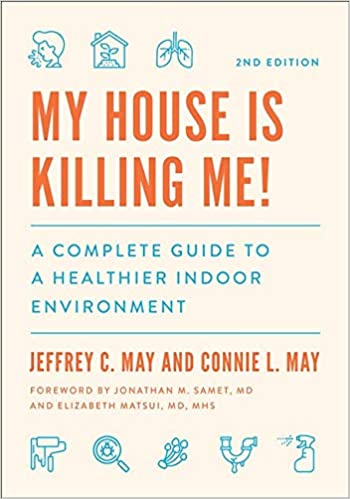
My House is Killing Me! A Complete Guide to a Healthier Indoor Environment
Jeffrey C. May and Connie L. May
Reviews:
“This new edition is even better than the first. A must-read for patients with respiratory problems and the physicians who care for them.” (Richard Stephen Irwin, MD., University of Massachusetts Medical School)
“It is my privilege to recommend Jeff and Connie May’s new edition of My House is Killing Me. It is incredibly informative, comprehensive, and easily digestible. It has broad appeal and is an excellent guide for the general public as well as medical practitioners. A highly valuable resource!” (Alex Bingham, MD., Northeast Functional Medicine)
MAY INDOOR AIR INVESTIGATIONS LLC
Tyngsboro, MA 01879 978-640-1055 www.mayindoorair.com
Remove Potential Sources of Allergens, Irritants, and Contaminants for Healthier Indoor Air
- Keep surface water out of your basement or crawlspace by keeping gutters and downspouts clean and by directing downspout water away from the foundation wall.
- Possessions stored in an unfinished basement should be up off the floor and away from foundation walls; rolling metal shelves are best. Nothing biodegradable (cardboard, wood, paper) should be placed on concrete or be leaning up against a concrete wall in a garage or basement.
- Basements – both finished and unfinished – should be dehumidified in the humid season, though sometimes air conditioning in finished basement spaces is sufficient.
- Hang a dehumidifier over a sink or sump or attach it to a condensate pump so that it can drain into a sink or sump or directly to the exterior; otherwise, the machine will shut off when the reservoir is full, defeating the machine’s purpose
- Finished basements should be consistently heated in winter, with the thermostat set at a minimum of 60oF.
- Measure the relative humidity (RH) in your basement with several thermo-hygrometers placed on or near the floor in cool corners. The RH should be no higher than 50% in an unfinished basement and 60% in a finished basement.
- Crawlspaces should not have exposed dirt floors and should be sealed from the exterior and dehumidified.
- Check that there are no openings such as spaces around pull-down stairs or an access hatch that could allow moist house air to rise up into your attic.
- A bathroom exhaust should vent to the exterior and not into the attic or a soffit.
- Install an airtight, insulated “attic tent” or foam box over the access to the attic.
These and many more recommendations can be found in our books Jeff May’s Healthy Home Tips and the just published My House is Killing Me: A Complete Guide to a Healthier Indoor Environment. Available online, both books are published by Johns Hopkins University Press.
